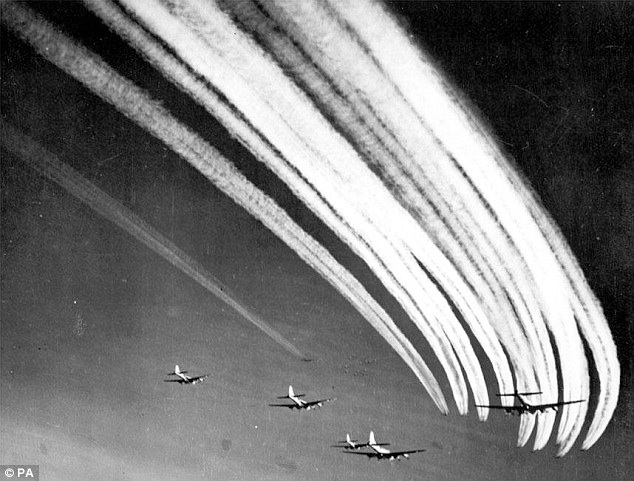How Allied bombing raids in World War Two caused havoc... on the climate: Contrails kept morning temperatures down
Last updated at 1:17 PM on 8th July 2011
The devastating impact of Allied bombers on the enemy played a pivotal role in winning the Second World War - but today they could tell us more about the impact that flying has on our climate, scientists claimed.
Researchers have examined meteorological data from wartime bombing raids to see exactly what effect thousands of aircraft have on the skies.
Analysis of Met Office and military records revealed significant change to the sky on May 11, 1944, when 1,444 aircraft took off from airfields across south-east England.

Leaving a mark: Vapour trails from B-17 planes above the skies of south-east England as they head for Germany during the Second World War
Contrails from the bombers significantly suppressed the rising morning temperature in the area.
Professor Rob MacKenzie, from the University of Birmingham, who led the study, said: 'Witnesses to the huge bombing formations recall that the sky was turned white by aircraft contrails.
'It was apparent to us that the Allied bombing of World War 2 represented an inadvertent environmental experiment on the ability of aircraft contrails to affect the energy coming into and out of the Earth at that location.'
The research is published today in the International Journal of Climatology.
Aircraft contrails are formed when hot, aerosol-laden air from a plane's engines mix with cold air in the upper troposphere.
While some contrails swiftly disappear, others form widespread cirrus clouds which block both the sun's rays and heat energy from the ground. The effect is known as air induced cloudiness (AIC).
Today's busy skies make it difficult to research AIC. Air travel is growing at an annual rate of between three and five per cent for passenger planes and seven per cent for cargo flights.
On September 11, 2001, U.S. airspace was closed to commercial aircraft after the World Trade Center terrorist attacks, offering scientists a chance to study what happened when aircraft contrails were suddenly absent. However the results were not clear-cut.
The new research looked at the opposite effect, the impact of contrails on the normally empty skies of the 1940s.
Since weather conditions were so vital to the success of the bombing missions, they were observed very carefully.
Weather records revealed a small but significant temperature suppression by the contrails.
Only larger raids involving more than 1,000 aircraft that were followed by raid-free days with similar weather were investigated.
The study focused on a bombing campaign between 1943 and 1945 after the U.S. Air Force had joined the war effort.
Researchers chose the day of May 11, 1944, as the best case study.
Professor MacKenzie said: 'This is tantalising evidence that Second World War bombing raids can be used to help us understand processes affecting contemporary climate.
'By looking back at a time when aviation took place almost entirely in concentrated batches for military purposes, it is easier to separate the aircraft-induced factors from all the other things that affect climate.'